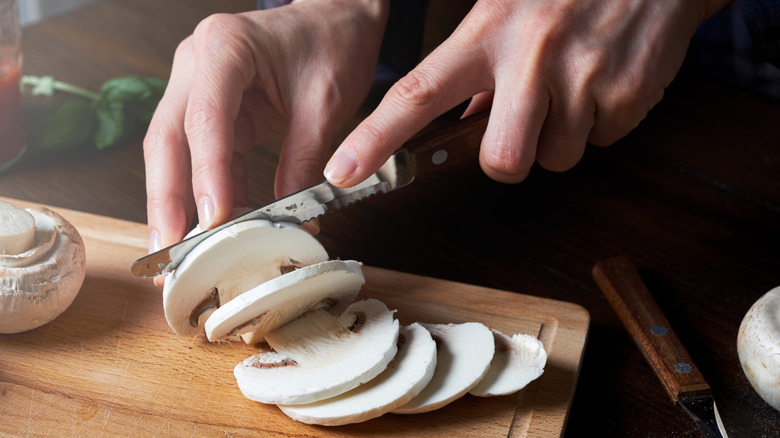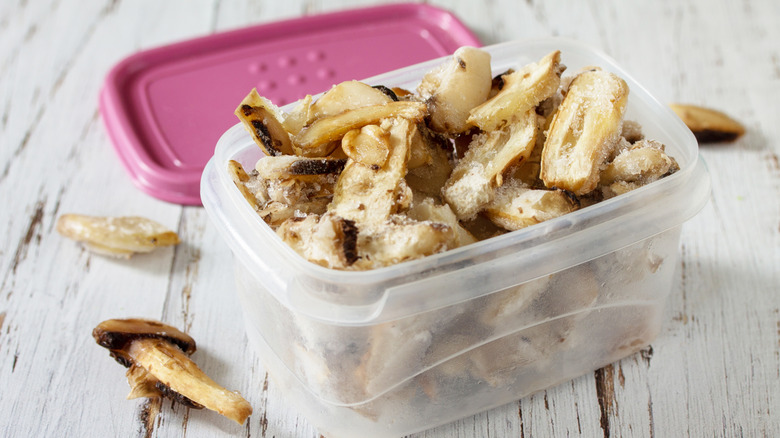Can we all agree that mushrooms are amazing? Whether added to a creamy garlic mushroom pasta or simply seasoned with salt and pepper and grilled to perfection, they make a flavorful and nutritious addition to almost any dish. Incorrectly storing them is just one of the many common mushroom mistakes everyone needs to stop making. That also includes how you freeze them. If you haven’t figured it out by now, mushrooms are indeed freezable, so you don’t really have to follow the U.S. Department of Agriculture’s recommendations and eat the whole package within a week after buying them from the store. Just take as many as you need and save the rest for later.
However, as with many things in life, there’s a catch, as freezing mushrooms doesn’t come without consequences. In this case, it’s how their texture, flavor, and moisture content change once they’ve spent some time in the freezer.
What happens to mushrooms when frozen?
Freezing is a convenient way to extend your leftover mushrooms’ shelf life for up to a year. But, the first thing you’ll notice when you decide to thaw them, whether in the fridge overnight or at room temperature, is that they will lose their initial firmness and turn soggy.
This is because of several reasons, the most critical being their high water content. Mushrooms comprise a whopping 92% water, so when defrosted, the science behind why frozen cucumbers always get mushy applies here as well. The ice crystals that form inside them when frozen rupture their cell walls, leaving them slimy and soft once defrosted.
Also, even though their flavor remains more or less the same, mushrooms lose some of the richness they had before being frozen. Acquiring a milder taste and losing their earthy kick are just some of the changes in their flavor profile. In addition, they can sometimes even change color and become a little darker. Thankfully though, the changes can be almost unnoticeable, and you can still use frozen mushrooms in stir-fries, in soups, or as pizza toppings.
Another change that takes place in frozen mushrooms is the loss of some of their nutrients. They keep most of their nutritional value, but the amount of water-soluble vitamins (like vitamins B and C) decreases — especially after more than 6 months of storage.
How to properly freeze mushrooms
Whether you decide to freeze your mushrooms for a pepperoni and mushroom pizza pasta or that mushroom risotto you’ve been craving, you won’t get too far unless you store them properly. Tossing them into the freezer fresh, right after you’ve brought them home from the market, isn’t the right method. Instead, you want to cook them first.
The golden rule: Never soak mushrooms in water! You don’t want them absorbing extra moisture and getting even mushier, right? Preferably, use a damp paper towel and wipe them down. Then comes the simple trick of cooking them before freezing. All it takes is a drizzle of olive oil or a tablespoon of butter and a frying pan to saute them, and they’ll be ready to freeze in just a few minutes.
Blanching is also an effective option, as it helps maintain the mushrooms’ authentic taste and keeps their nutrient content nearly intact. After you boil them for a couple of minutes, soak them in ice water to stop them from cooking further. Once that’s done, place them on a sheet of baking paper and freeze them – a technique commonly known as flash-freezing. This method leads to the formation of smaller ice crystals within the mushrooms, thus preserving their cell structure and texture.

